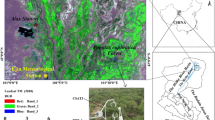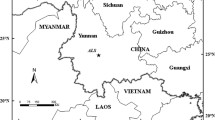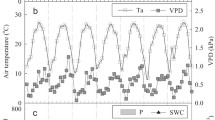Abstract
Understanding forest ecosystem evapotranspiration (ET) is crucial for water-limited environments, particularly those that lack adequate quantified data such as the lower Heihe River basin of northwest China which is primarily dominated by Tamarix ramosissima Ledeb. and Populus euphratica Oliv. forests. Accordingly, we selected the growing season for 2 years (2012 and 2014) of two such forests under similar meteorological conditions to compare ET using the eddy covariance (EC) technique. During the growing seasons, daily ET of T. ramosissima ranged from 0.3 to 8.0 mm day−1 with a mean of 3.6 mm day−1, and daily ET of P. euphratica ranged from 0.9 to 7.9 mm day−1 with a mean of 4.6 mm day−1 for a total of 548 and 707 mm, respectively. The significantly higher ET of the P. euphratica stand was directly linked to high soil evaporation rates under sufficient water availability from irrigation. When the soil evaporation was disregarded, water use was comparable to two contrasting riparian forests, a P. euphratica forest with a total transpiration of 465 mm and a T. ramosissima forest with 473 mm. Regression analysis demonstrated that climate factors accounted for at least 80% of ET variation in both forest types. In conclusion, water use of the riparian forests was low and comparable in this arid region, that suggest the long-term plant adaptation to the local climate and conditions of water availability.





Similar content being viewed by others
References
Allen R, Pereira LS, Raes D, Smith M (1998) Crop evapotranspiration-guidelines for computing crop requirements. In: FAO irrigation and drainage paper 56. FAO, Rome
Bawazir AS, Samani Z, Bleiweiss M, Skaggs R, Schmugge T (2009) Using ASTER satellite data to calculate riparian evapotranspiration in the Middle Rio Grande, New Mexico. Int J Remote Sens 30:5593–5603
Burba G, Schmidt A, Scott RL, Nakai T, Kathilankal J, Fratini G, Hanson C, Law B, McDermitt DK, Eckles R, Furtaw M, Velgersdyk M (2012) Calculating CO2 and H2O eddy covariance fluxes from an enclosed gas analyzer using an instantaneous mixing ratio. Glob Change Biol 18:385–399
Campbell GS, Norman JM (1998) An introduction to environmental biophysics. Springer-Verlag New York Inc, New York
Chen YN, Wang Q, Li W, Ruan X, Chen Y, Zhang L (2006) Rational groundwater table indicated by the eco-physiological parameters of the vegetation: a case study of ecological restoration in the lower reaches of the Tarim River. Chin Sci Bull 51:8–15
Cheng GD, Li X, Zhao WZ, Xu ZM, Feng Q, Xiao SC, Xiao HL (2014) Integrated study of the water-ecosystem-economy in the Heihe River basin. Natl Sci Rev 1:413–428
Cleverly JR, Dahm CN, Thibault JR, Gilroy DJ, Allred Coonrod JE (2002) Seasonal estimates of actual evapo-transpiration from Tamarix ramosissima stands using three-dimensional eddy covariance. J Arid Environ 52:181–197
Cleverly JR, Dahm CN, Thibault JR, McDonnell DE, Allred Coonrod JE (2006) Riparian ecohydrology: regulation of water flux from the ground to the atmosphere in the Middle Rio Grande, New Mexico. Hydrol Process 20:3207–3225
Dahm CN, Cleverly JR, Allred Coonrod JE, Thibault JR, McDonnell DE, Gilroy DJ (2002) Evapotranspiration at the land/water interface in a semi-arid drainage basin. Freshw Biol 47:831–843
Dennison PE, Nagler PL, Hultine KR, Glenn EP, Ehleringer JR (2009) Remote monitoring of tamarisk defoliation and evapotranspiration following saltcedar leaf beetle attack. Remote Sens Environ 113:1462–1472
Devitt DA, Sala A, Smith SD, Cleverly J, Shaulis LK, Hammett R (1998) Bowen ratio estimates of evapotranspiration for Tamarix ramosissima stands on the Virgin River in southern Nevada. Water Resour Res 34:2407–2414
Devitt DA, Fenstermaker LF, Young MH, Conrad B, Baghzouz M, Bird BM (2011) Evapotranspiration of mixed shrub communities in phreatophytic zones of the Great Basin region of Nevada (USA). Ecohydrology 4:807–822
Di Tomaso JM (1998) Impact, biology, and ecology of Saltcedar (Tamarix spp.) in the southwestern United States. Weed Technol 12:326–336
Feng Q, Cheng GD (1998) Current situation, problems and rational utilization of water resources in arid north-western China. J Arid Environ 40:373–382
Feng Q, Peng JZ, Li J, Xi HY, Si JH (2012) Using the concept of ecological groundwater level to evaluate shallow groundwater resources in hyperarid desert regions. J Arid Land 4:378–389
Foken T, Gockede M, Mauder M, Mahrt L, Amiro B, Munger W (2004) Post-field data quality control. In: Xuhui L, William M, Beverly L (eds) Handbook of micrometeorology: a guide for surface flux measurements. Kluwer Academic Publishers, New York, pp 181–203
Gao GL, Zhang XY, Yu TF, Liu B (2016a) Comparison of three evapotranspiration models with eddy covariance measurements for a Populus euphratica Oliv. forest in an arid region of northwestern China. J Arid Land 8:146–156
Gao GL, Zhang XY, Yu TF (2016b) Evapotranspiration of a Populus euphratica forest during the growing season in an extremely arid region of northwest China using the shuttleworth-wallace model. J For Res 27:879–887
Glenn EP, Nagler PL (2005) Comparative ecophysiology of Tamarix ramosissima and native trees in western U.S. riparian zones. J Arid Environ 61:419–446
Guo QL, Feng Q, Li JL (2008) Environmental changes after ecological water conveyance in the lower reaches of Heihe River, northwest China. Environ Geol 58:1387–1396
Hao YB, Wang Y, Huang X, Cui X, Zhou X, Wang S, Niu H, Jiang G (2007) Seasonal and interannual variation in water vapor and energy exchange over a typical steppe in Inner Mongolia, China. Agric For Meteorol 146:57–69
Hao XM, Li WH, Huang X, Zhu C, Ma J (2009) Assessment of the groundwater threshold of desert riparian forest vegetation along the middle and lower reaches of the Tarim River, China. Hydrol Process 24:178–186
Hatler WL, Hart CR (2009) Water loss and salvage in saltcedar (Tamarix spp.) stands on the Pecos River, Texas. Invasive Plant Sci Manag 2:309–317
Hou LG, Xiao HL, Si JH, Xiao SC, Zhou MX, Yang YG (2010) Evapotranspiration and crop coefficient of Populus euphratica Oliv forest during the growing season in the extreme arid region northwest China. Agric Water Manag 97:351–356
Nagler PL, Glenn EP, Lewis Thompson T (2003) Comparison of transpiration rates among saltcedar, cottonwood and willow trees by sap flow and canopy temperature methods. Agric For Meteorol 116:73–89
Nagler P, Scott R, Westenburg C, Cleverly J, Glenn E, Huete A (2005) Evapotranspiration on western U.S. rivers estimated using the Enhanced Vegetation Index from MODIS and data from eddy covariance and Bowen ratio flux towers. Remote Sens Environ 97:337–351
Nagler PL, Morino K, Didan K, Erker J, Osterberg J, Hultine KR, Glenn EP (2009) Wide-area estimates of saltcedar (Tamarix spp.) evapotranspiration on the lower Colorado River measured by heat balance and remote sensing methods. Ecohydrology 2:18–33
Sala A, Smith SD, Devitt DA (1996) Water use by Tamarix ramosissima and associated phreatophytes in a Mojave Desert floodplain. Ecol Appl 6:888–898
Shafroth PB, Cleverly JR, Dudley TL, Taylor JP, van Riper C III, Weeks EP, Stuart JN (2005) Control of Tamarix in the Western United States: implications for water salvage, wildlife use, and riparian restoration. Environ Manag 35:231–246
Si JH, Feng Q, Zhang XY, Liu W, Su YH, Zhang YW (2005) Growing season evapotranspiration from Tamarix ramosissima stands under extreme arid conditions in northwest China. Environ Geol 48:861–870
Si JH, Feng Q, Zhang XY, Chang ZQ, Su YH, Xi HY (2007) Sap flow of Populus euphratica in a desert riparian forest in an extreme arid region during the growing season. J Integr Plant Biol 49:425–436
Si JH, Feng Q, Cao SK, Yu TF, Zhao CY (2014) Water use sources of desert riparian Populus euphratica forests. Environ Monit Assess 186:5469–5477
Smith SD, Devitt DA, Sala A, Cleverly JR, Busch DE (1998) Water relations of riparian plants from warm desert regions. Wetlands 18:687–696
Sun G, Noormets A, Chen J, McNulty SG (2008) Evapotranspiration estimates from eddy covariance towers and hydrologic modeling in managed forests in Northern Wisconsin, USA. Agric For Meteorol 148:257–267
Taghvaeian S, Neale CMU, Osterberg J, Sritharan SI, Watts DR (2014) Water use and stream-aquifer-phreatophyte interaction along a Tamarisk-dominated segment of the lower Colorado River. Remote Sens Terr Water Cycle, Geophysical Monograph 206, pp 95–113
Vickers D, Mahrt L (1997) Quality control and flux sampling problems for tower and aircraft data. J Atmos Ocean Technol 14:512–526
Wang P, Grinevsky SO, Pozdniakov SP, Yu JJ, Dautova DS, Min L, Du C, Zhang Y (2014) Application of the water table fluctuation method for estimating evapotranspiration at two phreatophyte-dominated sites under hyper-arid environments. J Hydrol 519:2289–2300
Westenburg CL, Harper DP, DeMeo GA (2006) Evapotranspiration by phreatophytes along the lower Colorado River at Havasu National Wildlife Refuge, Arizona. In: Geological survey scientific investigations report 2006-5043. Henderson
Wilson K, Goldstein A, Falge E, Aubinet M, Baldocchi D, Berbigier P, Bernhofer C, Ceulemans R, Dolman H, Field C, Grelle A, Ibrom A, Law BE, Kowalski A, Meyers T, Moncrieff J, Monson R, Oechel W, Tenhunen J, Valentini R, Verma S (2002) Energy balance closure at FLUXNET sites. Agric For Meteorol 113:223–243
Yu TF, Feng Q, Si JH, Xi HY, Li W (2013a) Patterns, magnitude, and controlling factors of hydraulic redistribution of soil water by Tamarix ramosissima roots. J Arid Land 5:396–407
Yu TF, Feng Q, Si JH, Xi HY, Li ZX, Chen AF (2013b) Hydraulic redistribution of soil water by roots of two desert riparian phreatophytes in northwest China’s extremely arid region. Plant Soil 372:297–308
Yuan GF, Zhang P, Shao MA, Luo Y, Zhu XC (2014) Energy and water exchanges over a riparian Tamarix spp. stand in the lower Tarim River basin under a hyper-arid climate. Agric For Meteorol 194:144–154
Zhang XY, Kang ES, Si JH, Zhou MX (2006) Stem sap flow of individual plant of Populus euphratica and its conversion to forest water consumption. Scientia Silvae Sinicae 42:28–32
Acknowledgements
The authors would like to thank two anonymous reviewers for their constructive and valuable assessment and comments, which helped to improve this article.
Author information
Authors and Affiliations
Corresponding author
Additional information
Project funding: This study was supported by the National Natural Science Foundation of China (41401033, 31370466, and 41271037), the China Postdoctoral Science Foundation (2014M560819) and the National Key Research and Development Program of China (2016YFC0501002).
The online version is available at http://www.springerlink.com
Corresponding editor: Hu Yanbo.
Rights and permissions
About this article
Cite this article
Yu, T., Feng, Q., Si, J. et al. Comparable water use of two contrasting riparian forests in the lower Heihe River basin, Northwest China. J. For. Res. 29, 1215–1224 (2018). https://doi.org/10.1007/s11676-017-0540-2
Received:
Accepted:
Published:
Issue Date:
DOI: https://doi.org/10.1007/s11676-017-0540-2




